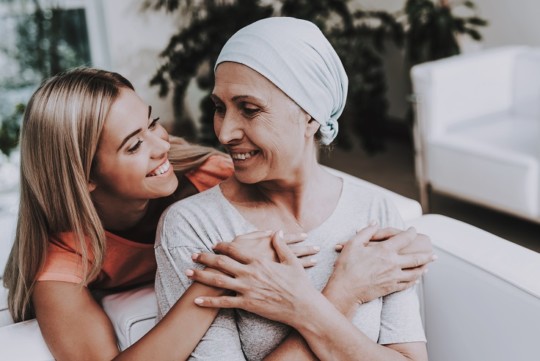October is Breast Cancer Awareness Month, an annual campaign to increase awareness of the disease. To help do our part, The Greek Herald has compiled a list of important facts about breast cancer, with a special focus on the importance of early detection.
What is breast cancer:
Breast cancer is a disease in which malignant (cancer) cells form in the tissues of the breast.
In Australia, it is the second largest cause of death in women after lung cancer. Approximately 17,000 women are also diagnosed with breast cancer every year.
Although no one knows the exact cause of breast cancer, the National Breast Cancer Foundation states that there are risk factors (some avoidable, others not), which make women more susceptible to the disease. These are:
- Alcohol intake.
- Obesity.
- Smoking.
- Gender (while some men do get breast cancer [estimated at 1 in 675], women make up 99 percent of cases).
- Age (the older women get, the higher their risk of developing breast cancer).
- Family history / Genetics.

Early Detection:
Early detection of breast cancer provides the best chance of survival. The earlier an abnormality is discovered, the greater the number of effective treatment options available.
There are many ways breast cancer can be detected. These include: Clinical examination, mammograms, Magnetic Resonance Imaging (MRI), Ultrasound and biopsy.
The Australian government offers a national screening program, BreastScreen Australia, which invites women aged 50 to 74 to undergo free mammograms every two years.
Similarly, it is also important to be ‘breast aware’ so that you can identify any unusual changes. According to the National Breast Cancer Foundation, symptoms of breast cancer include:
- A lump or thickening in the breast, especially if it is only in one breast.
- Changes to the shape or size of the breast.
- Changes to the shape of the nipple, such as crusting, sores or ulcers, redness or inversion (a nipple that turns in when it used to point out).
- Changes to the skin of the breast, such as dimpling (sometimes looking like an orange peel), a rash, scaly appearance, unusual redness or other colour changes.
- Fluid leaking or discharge from the nipple that occurs without squeezing.
- Persistent, unusual pain that doesn’t go away.
- Swelling or discomfort in the armpit.

Please note that most breast changes are not caused by cancer, and the symptoms listed can be caused by other medical conditions.
However, if you have noticed any symptoms or changes in your breasts, it is important that you see your doctor without delay so that the changes can be checked.
Diagnosis – Stages and Types
Breast cancer staging describes how far the cancer has spread within the breast and other parts of the body. It is an important factor in making treatment decisions. Stages of breast cancer are numbered from 0 to 4.
Stage 0 refers to ‘pre-invasive’ breast cancers.
Stage 1 and 2 are referred to as early breast cancer.
- Stage 1 and 2 breast cancer is invasive breast cancer that is contained within the breast. It may or may not have spread to the lymph nodes in the breast or armpit. Some cancer cells may have spread outside the breast and armpit area but cannot be detected.

Stage 3 is referred to as locally advanced breast cancer.
- It is invasive breast cancer that has one or more of the following features: may be large (typically bigger than 5cm), may have spread to lymph nodes in the underarm area or other areas near the breast, and may have spread to other tissues around the breast such as skin, muscles or ribs.
Stage 4 is called advanced or metastatic breast cancer. At this stage, the cancer has spread to other parts of the body.
- Common places of breast cancer spread include the bones, liver, lung, and brain. However, breast cancer may also spread to other organs.
Treatment:
If you have been diagnosed with breast cancer, there are a number of treatment options. Some are described below but these descriptions are not intended to be exhaustive or replace professional medical advice.
Please consult with your doctor or cancer care team if you are concerned about the risks and side effects of any recommended treatment.
Surgery:
Surgical treatment is an operation where the doctor removes the tumour. This is one of the common treatment options for women with breast cancer. The two main types of surgery are:
- Breast-conserving surgery where the surgeon removes the tumour and some surrounding tissue, leaving as much breast tissue as possible.
- A mastectomy is the removal of the entire breast. Some women may choose to have a double mastectomy, where both breasts are removed. A woman may opt to have breast reconstruction surgery at the same time as her mastectomy, but it may also occur later as a separate operation.

Chemotherapy:
Chemotherapy is the administration of anti-cancer drugs to kill cancer cells.
Chemotherapy can be given intravenously (injected into your vein) or orally. The drugs used will depend on the type and stage of breast cancer. There are often side-effects associated with chemotherapy, including nausea, fatigue, hair loss, mouth ulcers and constipation.
Radiotherapy:
Radiotherapy is the use of targeted radiation, such as x-rays, to destroy cancer cells or keep them from growing. It may be given externally or internally.
If you would like to find out more information about breast cancer, please visit the National Breast Cancer Foundation‘s website. It has provided a basis for this article.
